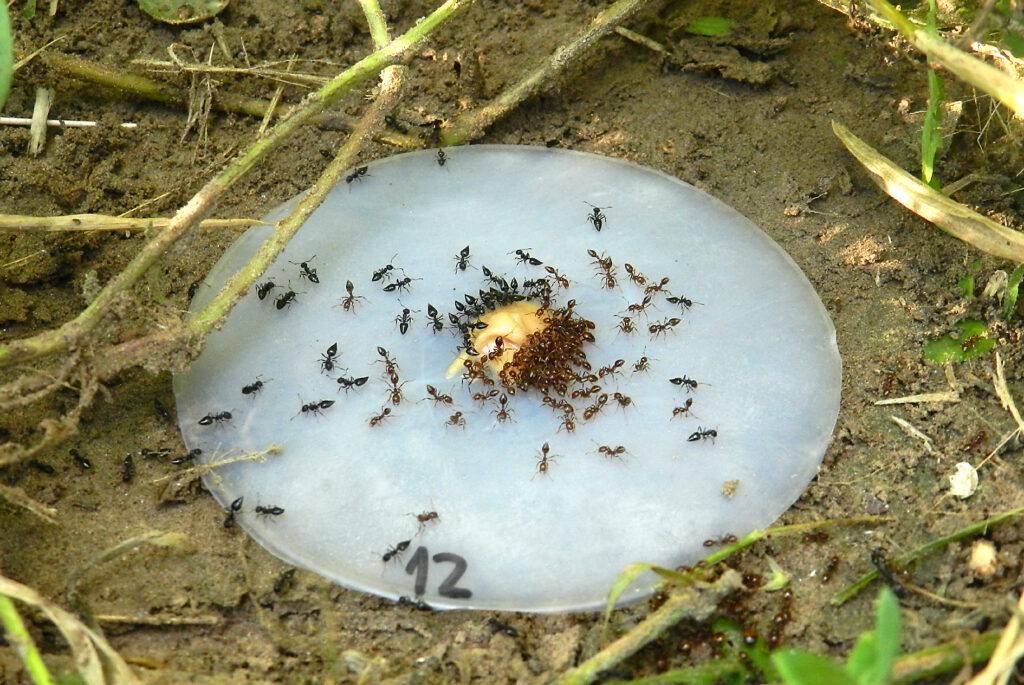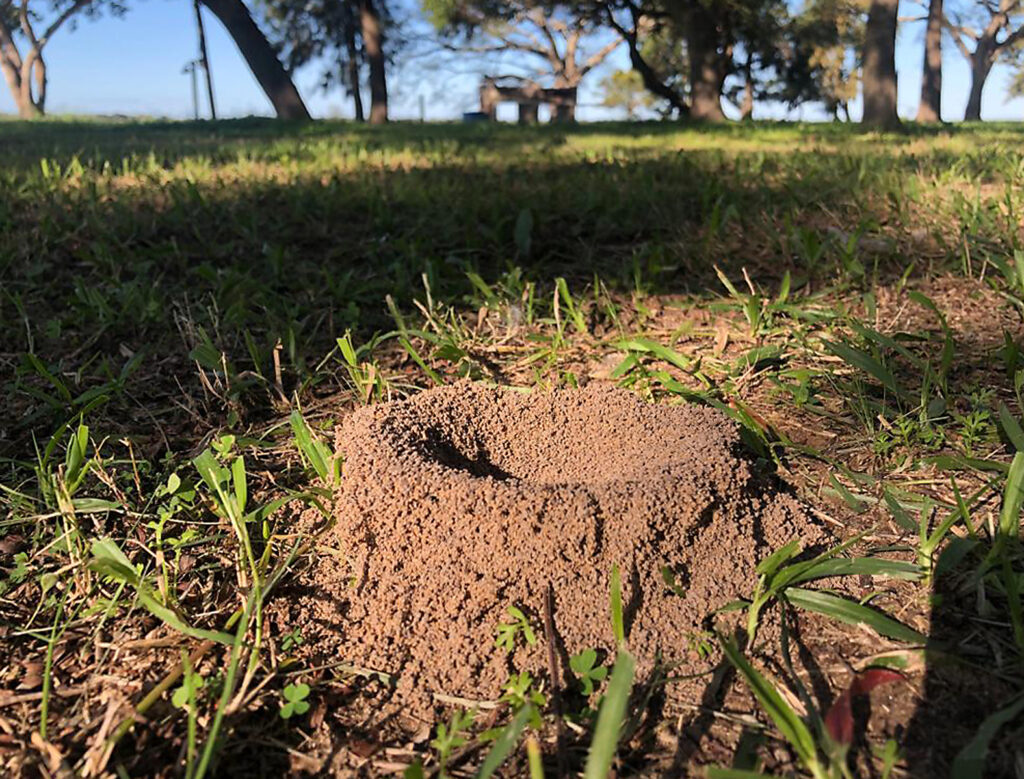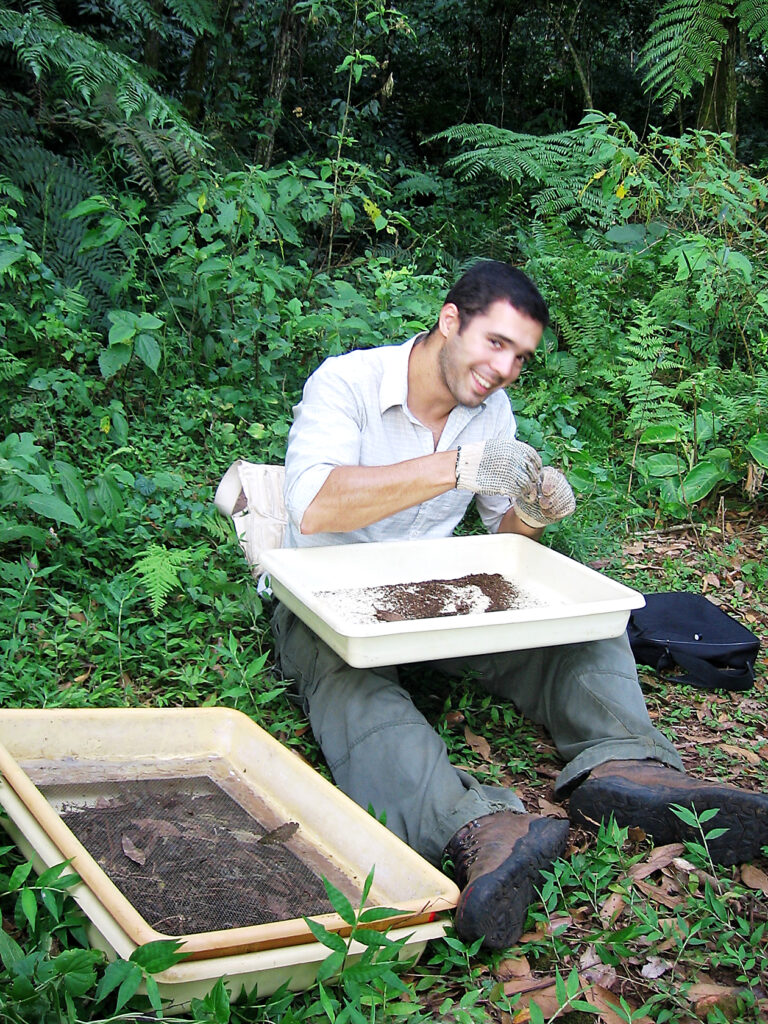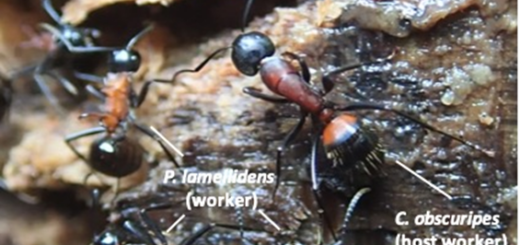Ground-dwelling ant diversity in South American subtropical forests

In the article “Diversity of ground-dwelling ants across three severely threatened South American subtropical forests: are diversity patterns influenced by spatial or climatic variables?” published in January 2022 (online first October 2021) in Insect Conservation and Diversity, Calcaterra et al.* investigate distribution patterns of ground-dwelling ants in 38 sites in Argentina. They analysed species richness, turnover and composition within and between forests, and whether spatial and climatic variables explain diversity patterns. The authors collected 161 species (38 genera) and detected a high level of species replacement. Here, the corresponding author Andrés F. Sánchez-Restrepo highlights the main points.
* = Luis A. Calcaterra, Lucila Chifflet, Fabiana Cuezzo, and Andrés F. Sánchez-Restrepo
An Interview compiled by Phil Hönle, Patrick Krapf, and Sheethal Vepur

MNB: Could you tell us a bit about yourself?
AFSR: My name is Andrés F. Sánchez Restrepo, I am a myrmecologist, but in my second life I am an origamist. I always wanted to be a biologist. In the last years of school, I had the good fortune to learn about the world of insects from a great entomologist, since then I tried to guide my career towards this field. I studied Biology at Pontificia Universidad Javeriana (Bogotá, Colombia). At this university, I got involved with the entomology laboratory in which I did my graduate work studying canopy ants in the Colombian Amazon. After working in different institutions on projects related to insects, I moved to Buenos Aires to do my Ph.D. at the University of Buenos Aires (UBA), supervised by Dr. Luis Calcaterra (FuEDEI / CONICET) and Dra. Viviana Confalonieri (UBA / CONICET). In my thesis project, I conducted phylogenetic and phylogeographic studies about the southern South American leaf-cutting ants (Acromyrmex spp., Amoimyrmex spp. and Atta spp.) to understand the evolutionary historical processes, centers of genetic diversity, and the routes of dispersion responsible for the contemporary geographic distributions of the leaf-cutting ants in southern South America. Currently, I have a postdoctoral CONICET (Consejo Nacional de Investigaciones Científicas y Técnicas) fellowship in the Foundation for the Study of Invasive Species (https://fuedei.org/), located in Hurlingham, Buenos Aires, Argentina. My current research interests are related to the distribution, biogeography, and evolutionary history of the South American ants, with a particular focus on ant species with invasive capacity and leaf-cutting ant species considered pests.
MNB: Could you briefly outline the research you recently published in layman’s terms?
AFSR: Subtropical forests harbor a large number of ground-dwelling ants. However, most of these forests have been largely transformed in the last decades due to the advancements in agriculture, mainly in regions previously used for cattle ranching and forestry production or extraction of wood from native forests. Research on ant fauna in subtropical forests of South America has been mostly focused on the ant community structure in a single study area or in a particular region. In our work, we want to expand this approach and compare the ant diversity between three highly fragmented subtropical forests of Argentina: the Andean, Chaco, and Atlantic forests. We estimated patterns of species richness, composition and turnover, and the potential role of spatial and climatic variables in shaping ant assemblages. For the first time in southern South America, ant communities from multiple subtropical forest fragments were sampled, encompassing a broad geographic scale with large spatial and climatic variations. As a result, we recorded 161 species belonging to 38 genera. The Atlantic forest had the highest species richness (91 species), followed by the Chaco (60 species) and Andean (52 species) forests. We found no differences in species richness and turnover between the forest types, though intriguingly both metrics tended to increase from west to east. Species diversity was positively associated with a decrease in precipitation seasonality, which shows that higher environmental stability could be associated with higher biodiversity, at least in ground-dwelling ants. This project was led by Dr. Calcaterra, and some of the following questions are answered with him.

MNB: What was your motivation for this study?
AFSR and LAC: This study started as a consequence of a project carried out by Dr. Calcaterra to detect the presence and abundance of the little fire ant Wasmannia auropunctata in its native range in Argentina. One of the goals included also the search for potential natural enemies, which could be used as biocontrol agents in its introduced range. To this end, a rapid protocol was developed to locate colonies of this ground-dwelling ant species using a combination of baits and leaf-litter sieves in forest fragments in northern Argentina. This procedure allowed us to collect information on this ant species in an extensive area proving that W. auropunctata is widely distributed in fragmented forests throughout northern Argentina (Chifflet et al. 2018). We know that a rapid assessment is never an exhaustive inventory and will not record most of the ant species present in an area. It usually implies a quality loss in comparison to traditional methods (e.g., “Ants of the Leaf Litter” protocol), which requires more time to sample and to identify specimens. However, when we analyzed all the samples from the Wasmannia study in more detail, we discovered that we had collected a larger ant diversity than we had imagined. We also discovered interesting patterns, such as a clear differentiation of ant communities between the three types of forest. Thus, when we decided to analyze these diversity patterns in relation to spatial and climatic variables, we found that species richness and water availability along the year were positively correlated, mainly along an east to west 1,000 km gradient.

MNB: What is the take-home message of your work?
AFSR and LAC: Even though the initial objective of this study was not to study ant diversity along subtropical forests, our methodology allowed us to compare ant species diversity between forests encompassing a wide geographic range, and to evaluate the influence of spatial and environmental variables in diversity patterns. The knowledge of species richness and turnover patterns in multiple sites within subtropical forests may help to identify the areas that need protection; especially given the scarce information available on ant diversity for several ecoregions within these biomes. The high level of species replacement across and among fragmented forests in northern Argentina resulted in unique assemblages (with at least 29 species that seem to be exclusive to one forest), indicating that urgent efforts are needed to conserve the biodiversity within these three strongly threatened subtropical forests.
MNB: What was the biggest obstacle you had to overcome in this project?
AFSR and LAC: In studies that cover large geographic regions, ideally is to have the resources to be able to carry out a complete and detailed study of their diversity, which is not always possible due to lack of time and funds. One of the obstacles is related to the lack of more complete knowledge of the ant species that inhabit the subtropical forests. For several of the ants studied they could only be identified to morphospecies (e.g., in genera such as Pheidole and Solenopsis), limiting the ability to detect more endemic species. To establish a comparison between forests, it was necessary to unify the different morphospecies among the three forest types. This represented a great challenge since we had to pay great attention to the morphological characters that we used for the identification of these entities among the three forests. In this type of study, more funding for genetic studies (i.e., barcodes) will surely allow to corroborate the identity and/or unification of the morphospecies with greater certainty.

MNB: Do you have any tips for others who are interested in doing related research?
AFSR: In this type of study that covers different geographic areas, a previous review of local studies is essential, to gather background knowledge on potential species that will be encountered during the field surveys. However, as in this case, the available information can be scarce. If large geographic regions are covered, it is essential to plan the field trips to find the most strategic areas. A team working collaboratively is another important point. Each of the authors of this work (Lucila, Fabiana, Luis, and me) contributed from their knowledge to enrich the publication. The community of myrmecologists is becoming more and more connected and nurtured. In all research, collaboration/cooperation is of enormous help.
MNB: Where do you see the future for this particular field of ant research?
AFSR: Ant surveys are absolutely necessary to know the current extant species, before ant assemblages completely change their composition and many species disappear locally and regionally in the ecosystems that are most affected by human activities. Also, studying the distribution and richness patterns of ants over wide geographic ranges allows us to identify new patterns and propose biogeographic and macro-evolutionary hypotheses. For example, in our study, we identified five species that are shared between the Andean and Atlantic forests. These species may be good candidates to conduct additional phylogenetic studies to test biogeographic scenarios, such as the trans–Chaco Pleistocene paleobridge hypothesis, which indicates the existence of past connections between the Yungas and the Atlantic forests through gallery forests of the Pilcomayo and Bermejo rivers during warmer and wetter Pleistocene periods.
References
Chifflet, L., Guzmán, N. V., Rey, O., Confalonieri, V. A., & Calcaterra, L. A. 2018: Southern expansion of the invasive ant Wasmannia auropunctata within its native range and its relation with clonality and human activity. – PLoS One, 13, e0206602







Recent Comments